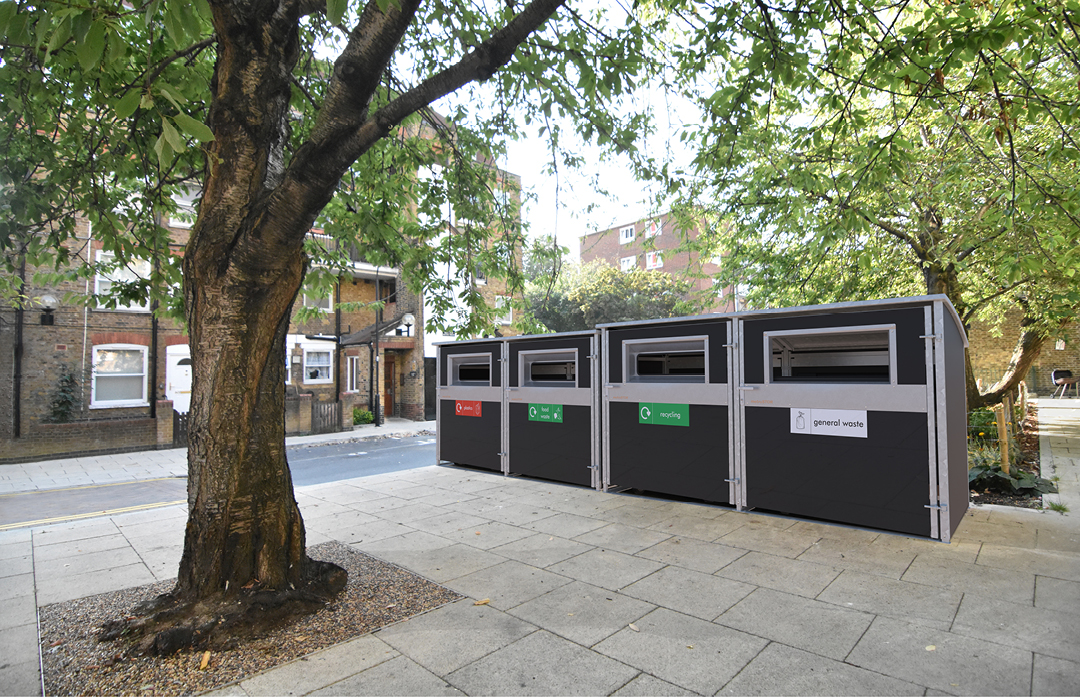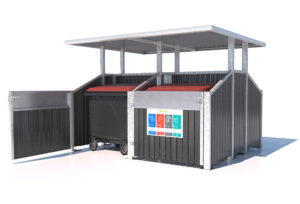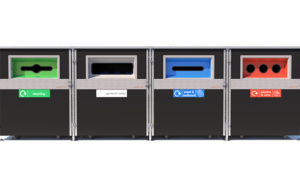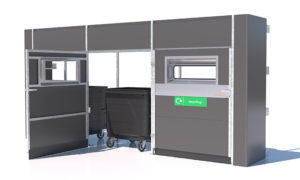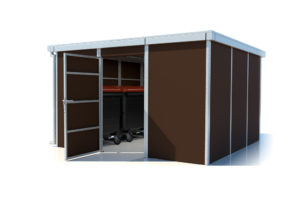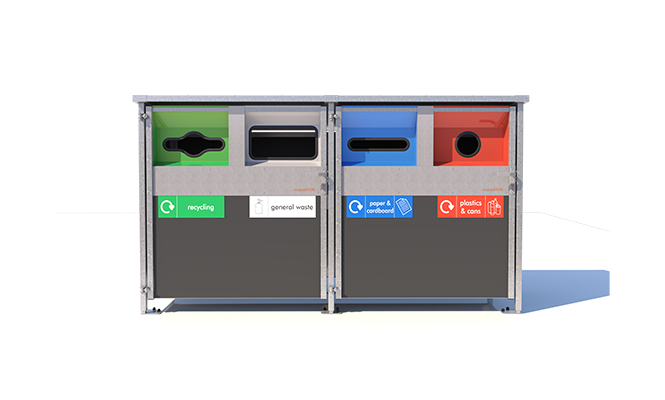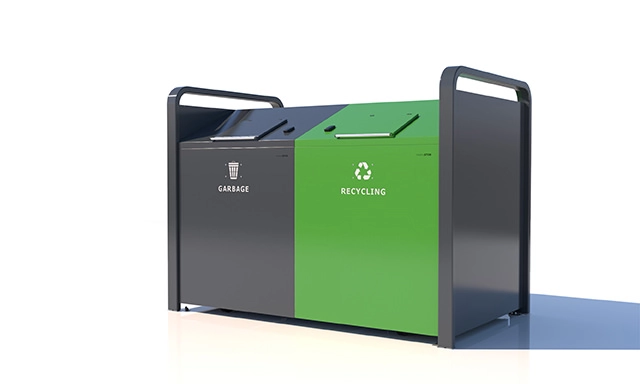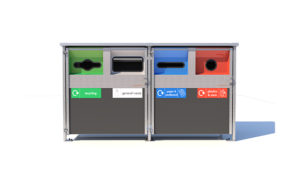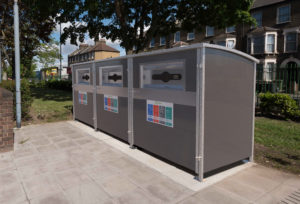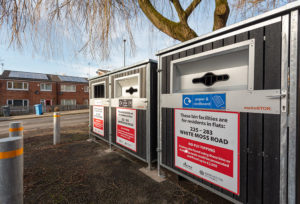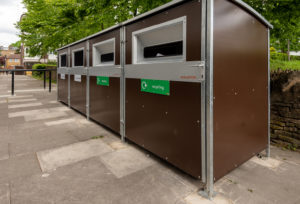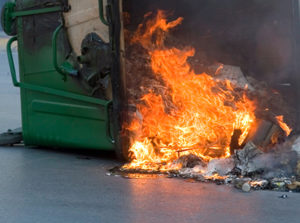We all applaud our front-line housing services staff during the current pandemic, and rightly so, as bin crews and caretakers continue to deal with increased waste volumes while at higher risk from biological hazards.
In times less fraught than these, the task of maintaining neighbourhoods as safe and pleasant places to live has frequently been hampered by refuse storage facilities that are no longer fit for purpose, particularly with the demands of today’s circular economy.
With the right measures in place, every pound that landlords invest in enhanced bin storage facilities can reap dividends in terms of reduced carbon footprint and operating costs, less exposure of tenants and staff to risk, less time wasted on cleaning up waste leading to more resource available for productive tasks.
Looking forward, metroSTOR has introduced a simple 10-point plan to demonstrate how you can resolve even the most demanding of refuse storage situations, successfully eliminating fire risk, overflowing bins, side waste and fly-tipping while improving neighbourhood quality of life and increasing the proportion of clean recycling collected.
Firstly, there are three key areas bin storage design must address; Fire Risk, Waste Costs and Recycling, then the ten steps that are critical to ensure your facility is a success.
1. Ensure residents are safe from the risk of bin fires
The storage of refuse and recyclable materials represents an inherent fire risk due to its combustibility, the excessive heat and smoke that is given off in the event of a fire and the risk this poses to life when stored close to dwellings and particularly those with communal spaces.
Bin stores in the traditional sense are often internal and may be fed by internal chutes, and there are significant costs associated with keeping these safe in terms of sealing the doors, hoppers and chutes to prevent toxic smoke spreading within the building, to the extent that many landlords are sealing them up and moving the bins to an external location.
External bin rooms are often located close to building entrances and can still represent a significant risk, particularly when combined with the presence of side waste and bulky items such as discarded furniture and mattresses which can in themselves be an arson trigger, and further still where they are insecure and in areas frequented by rough sleepers or drug-users.
The original bin store will almost certainly not have sufficient capacity for the number of waste and recycling bins now required by the local authority collection frequencies, leading to additional loose bins being stored within the communal space, which represent a serious risk to residents.
Fire Risk Assessors frequently identify these as a risk which must be addressed urgently, based on guidance from the CFPA-E on bin separation distances from dwellings; their headline statement, `bins should not be stored within 6m of dwellings’ has been adopted by many organisations but we consider this to be misleading.
The safety distance will vary according to the number and size of the bins, and this is calculated by taking the width of object facing the dwelling plus 2.5m, and should not be measured from the closest point of the dwelling but the closest point at which fire could enter, i.e. door or window opening, for example.
2. Eliminate unscheduled waste costs in housing
Council waste and recycling contractors are not obliged to collect over-presented material, bulky items or bins that are contaminated or overfilled, so any additional visits and disposal costs incurred fall to the landlord as an unscheduled expense that has to be taken out of another budget that would have been spent on something of greater value to the community.
Over-presentation can occur because there is insufficient storage capacity, so it is important to ensure that there is room to store the correct number of bins and that they are all easily accessible. It can also be caused by users being unable to lift the lids or disinclined to do so for hygiene reasons, and we always advise designing a store that can be loaded from the outside without the need for users to touch anything.
It is somewhat unavoidable that bulky items tend to accumulate in areas where Councils charge for bulk collections, and the objective here is to design out free space where such items can be deposited, either within or immediately around the store. Some landlords provide storage space for bulky items awaiting collection to prevent them attracting fly-tipping.
Recycling bins can easily become contaminated with refuse or incorrect materials, resulting in a costly separate uplift and disposal. So it is essential that all recycling bins are clearly signposted indicating what items can and can’t be recycled and a physical means of preventing refuse bags being placed in the recycling bins.
3. Increase recycling participation and recycling quality in flats
Municipal recycling performance in the UK has flat-lined at around 44% for the last five years and has now started to fall, dashing hopes of achieving the current target of 50% by 2020. In addition to the endless debate about what can and can’t be recycled, I believe that there are two fundamental obstacles that must be resolved if we are to get anywhere near our target goal of 70% household waste recycled by 2025.
The first is making it easier for every household to consistently participate in recycling initiatives, particularly those living in flats or homes without space to store bins. The secret here is to make sure that every such home has easy access to a communal waste and recycling hub, either within the grounds of their block or at strategic locations in the street. Recognising that hygiene is one of the biggest barriers to participation the facility must also be kept clean at all times, and preferably enable users to place recycling in the relevant bin without having to touch lids or handles in any way.
10-Steps To Successful Communal Bin Store Facilities
Calling all landlords, councils and housing associations! Using expertise gained from thousands of bin store upgrades across the UK, our simple 10-point guide to successful communal bin store facilities explains how you can resolve even the most demanding of refuse storage situations. Eliminate issues such as fire risk, overflowing bins, side-waste and fly-tipping while improving neighbourhood quality of life and increasing the proportion of clean recyclate collected.
Download the PDF
1. Providing sufficient waste and recycling storage capacity between bin collections
Establishing the total storage capacity requirement for the number of properties concerned is information that can often be found on your local Council’s website. This is typically 70L of residual waste per flat per week with the same allowance for recycling. The recycling volume is often split into a number of separate fractions such as paper/card, plastic/tins/glass and food waste. An additional consideration is that these allowances may not be the same for flats as individual households so contacting your local waste and recycling officer for clarification is recommended.
metroSTOR PBC accommodates bins for different recycling streams
2. Specifying the correct bin size
Selecting the largest available bin size for the waste and recycling volume allowed per residential unit and using communal rather than individual bins wherever possible, will help reduce the required storage footprint and the cost of collection. With a properly designed store that can be easily accessed, residents will take ownership of large bins just as well as smaller ones. Always check with the waste and recycling officer what bin sizes the local council are able to provide in your immediate area.
metroSTOR PBM Bin Storage Units fit all 660L – 1280L bins
3. Finding accessible waste and recycling storage locations for users.
An accessible location that works for all residents using the bin store is fundamental. This should be located within 35m of the dwelling entrances and enable bins to be placed on a regularly-used route with good surveillance. Ensuring the bin stores are not tucked away in dark corners will encourage responsible use and also help eliminate anti-social behaviour. For very restricted sites it may be possible to utilise part of an underground car park or consider an underground refuse facility subject to land ownership and utility constraints.
metroSTOR PBF Internal Bin Room Dividers help create facilities which increase recycling
4. Ensuring bin store locations are readily serviceable
Careful planning is required to ensure proposed bin store locations can be safely and reliably accessed by bin crews. 4-wheeled bulk bins must be stored within 10m of a dropped kerb without any steps, sharp inclines or likelihood of being blocked by parked cars. The pull distance for 2-wheeled bins extends to 25m, and although these bins can be stored further away from the kerb, a reliable method for ensuring that the bins are presented for collection and returned to the store afterwards is essential.
metroSTOR PBH Bin Rooms have been installed for South Lanarkshire Council on the Ontario Park development
5. Removing bin fire risk
Establishing that bin store locations do not breach recommended safety distances from the dwelling is an essential first step. This is calculated by taking the width of those bins facing the dwelling plus 2.5m from any point where fire could penetrate the dwelling, e.g. window and door openings, extractor fans, soffits and combustible cladding. If it is possible to change the orientation of stored bins this may reduce the bin store width and therefore improve the safety distance. Where the recommended safety distance cannot be achieved then the bins must be contained within a structure providing at least 30-minutes fire resistance.
Find out more on our Reduce Fire Risk Page
6. Secure storage of waste and recycling bins
A reliable means of securing the bins in place must be provided, particularly if there is a likelihood of the safety distance being breached by unauthorised moving of bins closer to the dwelling, whether due to arson or for resident’s convenience. In its most basic form this security can be achieved with a simple bin lock barrier system. Where it is necessary to ensure the bins are used by the intended tenants only, and not neighbours or passers-by, then enclosed bin stores using RFID systems for access control can be considered.
metroSTOR Street Bin Enclosures secure bins in location helping to prevent vandalism
7. Designing bin stores that are easy to use
Where there is scope to install enclosures that allow residents to deposit their bagged refuse and recyclable items in the bins from the outside without opening any doors or bin lids; improved attitudes to recycling will follow. Making communal bin storage facilities easy to use is the key to both reduced contamination of recycling streams and reduced ASB issues as side waste is removed, and in turn, fly-tipping and arson.
We’ve helped the London Borough of Camden make recycling easy for their residents
8. Facilitating recycling segregation
Engaging residents in the consultation process for recycling initiatives and an ongoing effort to make participation as easy as possible for them will always pay off with better results. Providing clear, colour-coded signage and appropriately-sized apertures prevents bulky items from being placed in refuse bins and eliminates costly contamination of recyclable material. These commonly occurring scenarios both result in non-collection by bin crews with unnecessary expense and hassle incurred, making recycling bin storage key in maintaining environments.
metroSTOR offers a wide range of aperture options for all bin storage products
9. Paying attention to hygiene for waste and recycling storage
Communal bin storage facilities where users do not have to touch bin lids or handles to deposit waste and recycling is a significant step in achieving successful outcomes. The elimination of internal ledges where waste can accumulate, non-absorbent cladding materials that can be pressure-washed as part of a cleaning routine and robust manufacture are all essential to ensure the storage facility is maintained fully operational with vermin, foxes and seagulls excluded from the bins. Where bin store units are of sealed design, foot pedal operation of the receptacle provides hygiene and ease of use benefits.
We’ve helped Northwards Housing achieve success in reducing side waste and increasing recycling rate on the Dam Head Estate in Manchester
10. Developing waste and recycling hubs as a valuable neighbourhood resource
Carefully designed bin store facilities enable waste and recycling bins to be located in public areas without unacceptable visual impact or fire risk. They can then become places that people like to use because they feel safe; and extend to meeting points where residents can socialise. The use of bin housings will provide screening and visual enhancement, with signage to promote recycling and best practice. Where practical, consider adding a composter, vegetable planters and seating to create a communal recycling hub for the neighbourhood.
The London Borough of Lambeth has used metroSTOR Bin Stores to help design out ASB
